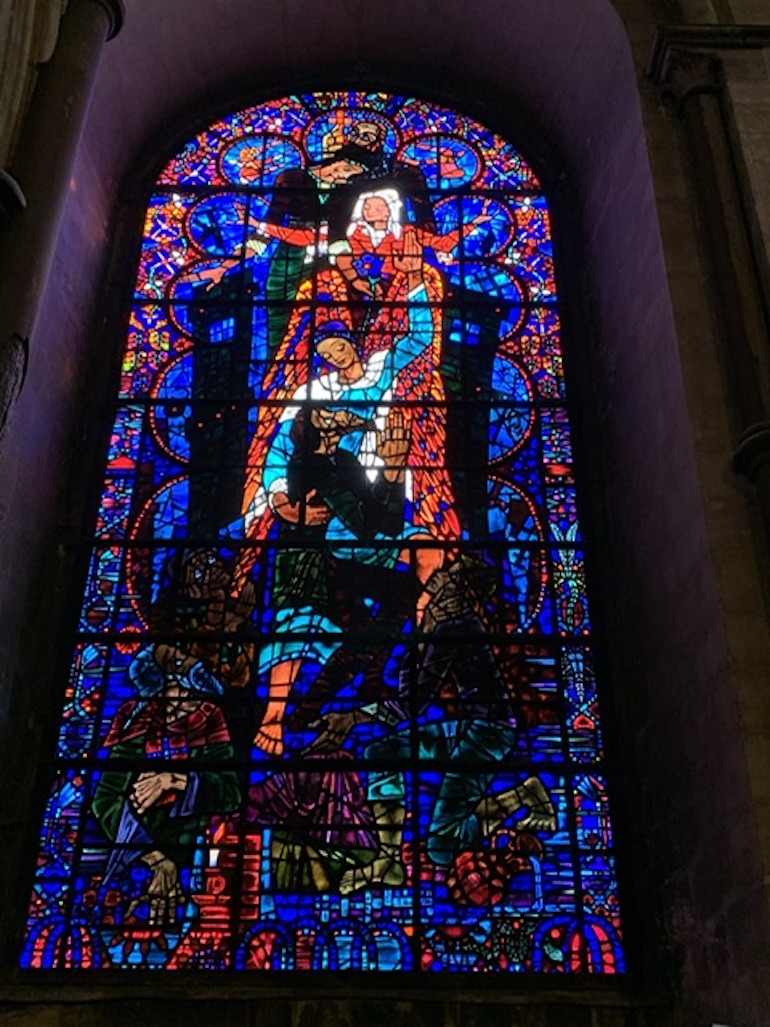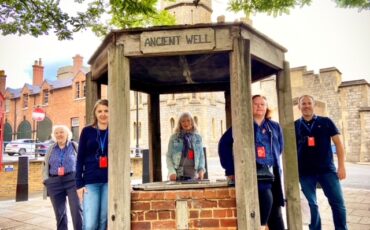Canterbury Cathedral covers 1,400 years of history and is today the seat of the Archbishop of Canterbury, the spiritual head of the Church of England. It was once one of the major pilgrimage sites in England until the Reformation in the 16th century. Today, Canterbury Cathedral is renowned for having some of the finest Medieval stained glass in the country as well as being one of the great Gothic style architectural buildings dating mainly from the 11th-16th century.
 Canterbury Cathedral. Photo Credit: © Antony McCallum via Wikimedia Commons.
Canterbury Cathedral. Photo Credit: © Antony McCallum via Wikimedia Commons.
History of Canterbury Cathedral
The first Canterbury Cathedral was founded in 597 AD by St Augustine who had been sent by Pope Gregory the Great in Rome. Why? The Pope had seen some children in the slave market, and when he asked who they were, he was told Angles – he replied no, they are Angels and insisted St Augustine go to England and convert the pagan Anglo-Saxons to Christianity. Nothing remains of the earlier buildings, which were damaged by invaders and then finally by a fire in 1067. It was rebuilt by Archbishop Lanfranc starting in 1070. From the 12th century onwards, successive Archbishops rebuilt Canterbury Cathedral over several hundred years in the new Gothic style. There are several ‘stand out’ sections of Canterbury Cathedral in this Gothic style with its pointed arches and pinnacles, including the crossing area, Quire, Trinity Chapel, and cloisters.
It was the murder in 1170 of Thomas Becket, Archbishop of Canterbury, after a long-standing disagreement between him and King Henry II that really brought Canterbury Cathedral to the fore. Henry is said to have uttered the words ‘who will rid me of this low born turbulent priest,’ and four knights took him at his word. They sailed to England, stormed into the North West transept of the Cathedral, and struck Becket down. Today the Martyrdom area and altar are at the same floor level as in Becket’s time. However, in the 16th century, during the Reformation, the shrine was destroyed, and Becket’s remains were burnt and thrown out on orders of King Henry VIII.
 Canterbury Cathedral. Photo Credit: © Karen Sharpe.
Canterbury Cathedral. Photo Credit: © Karen Sharpe.
Like many churches, Canterbury Cathedral suffered during the Civil War in the 17th century with Puritans destroying religious figures and glass and again in the 20th century during WWII and the ‘Baedeker Raids’ which were named after the Baedeker Guide Book. This is when the library was lost. The Cathedral’s survival was largely down to the Fire Watch (a group of people who put out incendiary bombs when they fell). The last major building work to take place was the rebuilding of the North West tower in the 19th century to make it appear in the same style as the South West tower, which dates from the 15th century.
The Medieval Stained Glass of Canterbury Cathedral includes the Genealogy Windows showing the descent of Christ from Adam, the oldest being recently dated to the early 1100s. The Miracle Windows depicts the various miracles attributed to Becket; there were 700 in the first ten years, all written down by the monks who kept watch over his shrine.
 Canterbury Cathedral. Photo Credit: © Karen Sharpe.
Canterbury Cathedral. Photo Credit: © Karen Sharpe.
The Royal Window depicts the Princes in the Tower – the two sons of Edward IV who disappeared in 1483, never to be seen again till the discovery of what are reputed to be their bones 200 years later at the Tower of London.
 Canterbury Cathedral. Photo Credit: © Karen Sharpe.
Canterbury Cathedral. Photo Credit: © Karen Sharpe.
In the 20th century, the Hungarian artist Erwin Bossayni created four stunning windows for Canterbury Cathedral, including ‘Salvation.’ At his death, his ashes were scattered in the Cathedral garden.
Royal Tombs at Canterbury Cathedral
Canterbury Cathedral has three royal tombs, although only one was ever a king. The first was Edward Black Prince, son of Edward III. He was famous for his prowess in war and is buried here along with his achievements (originals in the Treasury) -his helmet, tabard, shield, and gloves. The originals are on display in the Cathedral’s crypt.
 Canterbury Cathedral. Photo Credit: © Karen Sharpe.
Canterbury Cathedral. Photo Credit: © Karen Sharpe.
His nephew Henry IV (1399-1413) is buried on the opposite (North) side of the Cathedral. In 1399 Henry had taken the throne from his cousin Richard II, the Black Prince’s son and Richard was murdered the following year. In 1832, Henry’s coffin was opened just to check that he was actually there!
The final royal tomb at Canterbury Cathedral is of Lady Margaret Holland, grandmother of Margaret Beaufort, through whom the Tudor monarchs are descended. She married twice to royal husbands whose effigies are shown on her tomb. It was the rebuilding of this area (today the Warrior Chapel) for her tomb that caused the remains of Stephen Langton, the Archbishop associated with the Magna Carta (Great Charter) in 1215 to be moved – today his head is in the Cathedral, and his feet are outside the chapel wall!
Crossing Tower & Quire at Canterbury Cathedral
Once you walk up the steps to the screen on your way to the Quire, stop and look upwards at the fan vaulting (so-called as the ceiling ribs resemble a fan). This is situated on the crossing tower of Bell Harry Tower.
From here, enter the Quire. At 180ft/55m long, it is said to be the longest of any English Cathedral; it was designed by William of Sens and finished by William the Englishman. Here, you can see the stone ‘cathedra,’ the seat of the Archbishop. The floor rises as you move from west to east by levels till you reach the Trinity Chapel and shrine area, which once held the shrine of Thomas Becket; all that remains is a candle on the floor denoting its location.
 The Quire at Canterbury Cathedral. Photo Credit: © Diliff via Wikimedia Commons.
The Quire at Canterbury Cathedral. Photo Credit: © Diliff via Wikimedia Commons.
Cloisters at Canterbury Cathedral
Canterbury was once a monastery, and you can still see the remains of some of the buildings on the grounds today. It was the cloister built by Stephen Lote, the king’s master mason, in the 14/15th centuries that connected different parts of the monastery. If you look at the ceiling, it depicts 856 shields, badges, and coats of arms.
 Canterbury Cathedral. Photo Credit: © Karen Sharpe.
Canterbury Cathedral. Photo Credit: © Karen Sharpe.
What else does Canterbury have to offer?
Canterbury Cathedral is part of a UNESCO World Heritage Site, which includes the ruins of St Augustine’s Abbey, where the early Anglo-Saxon kings of Kent were buried, and St Martin’s, the longest church in continuous use in England. It was here that Ethelbert, King of Kent, was baptised in 597 AD by St Augustine. The city gates at Westgate Towers. Built in the 14th century, they are the largest surviving city gates in England, and pilgrims to Canterbury would hurry to get through them at night before they closed. It is said to be the origin of the word canter – to go at a ‘Canterbury pace.’
A day out is nothing without somewhere to eat, and Canterbury offers many options, including The Goods Shed, which has a farmers market, food hall, and restaurant.
Visiting from London – by train from St Pancras Station to Canterbury West is direct and less than one hour with just a three-minute walk which will then have you in the heart of Canterbury.
NOTE: London Blue Badge Tourist Guides can take you around Canterbury, although the cathedral insists that only its own cathedral guides can conduct tours inside the cathedral itself.







Leave a Reply